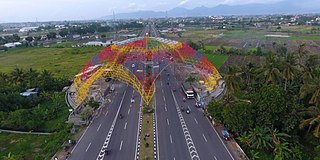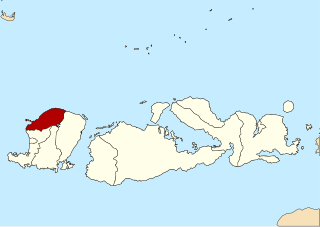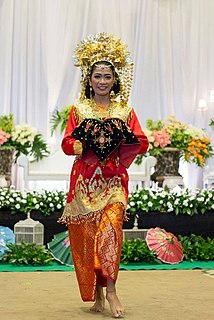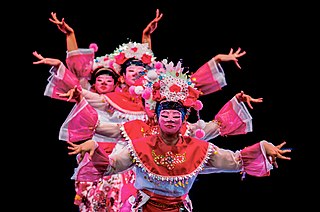
Lombok is an island in West Nusa Tenggara province, Indonesia. It forms part of the chain of the Lesser Sunda Islands, with the Lombok Strait separating it from Bali to the west and the Alas Strait between it and Sumbawa to the east. It is roughly circular, with a "tail" to the southwest, about 70 kilometres across and a total area of about 4,738.65 square kilometres. The provincial capital and largest city on the island is Mataram.

As it is a country with many different tribes and ethnic groups, the music of Indonesia itself is also very diverse, coming in hundreds of different forms and styles. Every region have its own culture and art, and as a result traditional music from area to area also uniquely differs from one another. For example, each traditional music are often accompanied by their very own dance and theatre. Contemporary music scene have also been heavily shaped by various foreign influences, such as America, Britain, Japan, Korea, and India.

The Sasak people live mainly on the island of Lombok, Indonesia, numbering around 3.6 million. They are related to the Balinese in language and ancestry, although the Sasak are predominantly Muslim while the Balinese are predominantly Hindu. Sasak people who practice pre-Islamic beliefs are also known as Sasak Boda in reference to the name of the Sasak people's original religion, Bodha.

Mataram is a city and the capital of the Indonesian province of West Nusa Tenggara. The city is surrounded on all the landward sides by West Lombok Regency and lies on the western side of the island of Lombok, Indonesia. It is also the largest city of the province, and had a population of 402,843 at the 2010 Census and 429,651 at the 2020 Census.

The Sasak language is spoken by the Sasak ethnic group, which make up the majority of the population of Lombok in Indonesia. It is closely related to the Balinese and Sumbawa languages spoken on adjacent islands, and is part of the Austronesian language family. Sasak has no official status; the national language, Indonesian, is the official and literary language in areas where Sasak is spoken.

East Lombok Regency is a regency of the Indonesian Province of West Nusa Tenggara. It is located on the island of Lombok, of which it comprises the eastern third ; the administrative capital is the town of Selong. The Regency covers an area of 1,605.55 km2 and had a population of 1,105,582 at the 2010 Census and 1,325,240 at the 2020 Census.

North Lombok Regency is a regency of the Indonesian Province of West Nusa Tenggara. It is located on the island of Lombok and the capital is Tanjung situated on the north coast of the island. The regency covers an area of 809.53 km2 and had a population of 199,904 at the 2010 Census and 247,400 at the 2020 Census.
Sasak architecture refers to the vernacular architecture of the Sasak, the majority indigenous ethnic group of the Indonesian island of Lombok.

Cirebonese mask dance is a local indigenous art form of Cirebon in Java, including Indramayu and Jatibarang, West Java and Brebes, Central Java. It is called mask dance because the dancers use masks when dancing. There is a lot of variety in Javanese mask dance, both in terms of the dance style and the stories to be conveyed. Sometimes the mask dance can be performed by solo dancers, or it can also be performed by several people. Tari topeng cirebon comprised Panji, Samba, Rumyang, Tumenggung and Kelana. Each mask represents different meanings. Panji represents holiness like a new born person. Samba represents a child and excitement. Rumyang represents a teenager and life. Tumenggung represents a wise person and loyalty. And last Kelana represents emotions, anger and hatred. All these meanings influence the dance movements. Panji has slow and soft dance movements, while Samba has fast dance movements.

Gandrung is a traditional dance from Indonesia. Gandrung has many variations and is popular in Bali, Lombok and Eastern Java among the Balinese, Sasak and Javanese. The most popular variation is gandrung from the Banyuwangi region in the eastern peninsula of Java, so much that the city is often referred as Kota Gandrung or "the city of gandrung". Originally a ritual dance dedicated to the goddess of rice and fertility, Dewi Sri, it is currently performed as a social dance of courtship and love in communal and social events, or as a tourist attraction. Gandrung Sewu Festival is held at Banyuwangi annually.

Gendang beleq is a dance and music performance from Lombok island, Indonesia. It is a popular performance among the native Sasak people.
West Nusa Tenggara State Museum is a state museum located in Mataram, Lombok Island, Indonesia. The museum is the provincial museum of the West Nusa Tenggara province.

Piring dance is a traditional Minangkabau plate dance originated from West Sumatra, Indonesia and performed both here and Negeri Sembilan, Malaysia. The dance might be performed by a group of women, men or couples, each of them holds plates in each hands, and vigorously rotate or half rotate them in various formations and fast movements.
Male'an Sampi is a traditional cattle race conducted annually in Lombok, West Nusa Tenggara, Indonesia. The race is open to the public. It takes place during the festival held following the harvest. Translated from the Sasak language, Male'an Sampi literally means to run or chase after (male'an) a cow or cattle (sampi). The race is not run on traditional racing terrain but rather on a rice paddy, requiring the cattle to struggle for approximately 200 meters through several inches or more of water. The individual animals are decorated by their respective owners to identify them during the race and add to the festive atmosphere.
Wetu Telu is a sect of Islamic beliefs of the Sasak people of Lombok, Indonesia. it differs from orthodox Sunni Islam in that practitioners pray three times a day, rather than five.

Pura Lingsar was built by Anak Agung Ngurah in 1714, located 15 km from Mataram. Lingsar origin from sasak language mean clear revelation from God, the area has a spring, which scared by Sasak people, who belief Wetu Telu.

Pasambahan dance is a Minangkabau traditional dance that has developed in various regions in the province of West Sumatra, Indonesia. Pasambahan dance is usually performed as a ceremonial welcoming dance to honor the guests and elders to a traditional ceremony. However, in nowadays, this dance is performed not only in ceremonial welcoming events, but also as performance art at public.

Gendang Beleq dance is a sacred folk dance tradition of Sasak people of Lombok in West Nusa Tenggara, Indonesia. This dance demonstrates dance performance with big drums, called gendang beleq.

The Betawi mask dance is a theatrical form of dance and drama of Betawi people in Jakarta, Indonesia. This dance-drama encompasses dance, music, bebodoran (comedy) and lakon (drama). The Betawi mask dance demonstrates the theme of Betawi society life which represented in the form of dance and drama. It is called mask dance because the dancers using topeng (mask) during dancing which Betawi people believed that the topeng has magical powers.



















